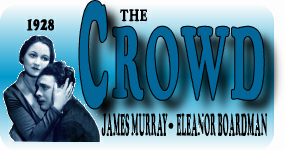

As "The Crowd" begins, a boy is born in an anonymous town on July 4th. His proud father says, "There's a little man the world is going to hear from all right, doctor. I'm going to give him every opportunity." Twelve years later, asked what the future holds for him, the boy answers confidently, "My dad says I'm going to be somebody big." Another decade passes, and he stares entranced at the New York City skyline as a ferry takes him into the metropolis. A cynical passer-by says, "You've gotta be good in that town if you want to beat the crowd." The boy replies, "Maybe -- but all I want is an opportunity." Minutes later, we see him the middle of a gigantic insurance office, one of hundreds of faceless drones who slave away at their dead-end jobs.
Working with those basic elements -- birth, job, girl, marriage,
and career - director King Vidor and scenarist John Weaver
fashioned a plot that is really no plot at all. John Sims (played
by James Murray), a nobody from nowhere, sustained only by his
energy and his belief in the American dream, moves to the big
city to make his mark. He gets a job. He meets a girl, Mary (played
by Eleanor Boardman), and marries her. They have two children.
Just as he gets a modest raise, his daughter dies. Devastated,
he 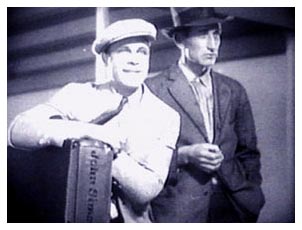 loses job after job, and his wife
prepares to leave him. He contemplates suicide while crossing
a bridge, but cannot do even that much. Redeemed by the love of
his adoring young son, he finally finds another menial job. His
wife returns, and the little family celebrates by going to a show.
As they laugh together, seated in the center of the theater and
surrounded by a sea of patrons, the camera pulls back farther
and farther until the little family fades into the crowd of hundreds
of other people laughing along with them -- all indistinguishable.
loses job after job, and his wife
prepares to leave him. He contemplates suicide while crossing
a bridge, but cannot do even that much. Redeemed by the love of
his adoring young son, he finally finds another menial job. His
wife returns, and the little family celebrates by going to a show.
As they laugh together, seated in the center of the theater and
surrounded by a sea of patrons, the camera pulls back farther
and farther until the little family fades into the crowd of hundreds
of other people laughing along with them -- all indistinguishable.
There's no sweeping grandeur to the story, no awe-inspiring climax (unless you count the contemplated suicide). There isn't even a tangible villain. As relayed in Kevin Brownlow's documentary "Hollywood" (Thames Television, 1980), Vidor saw no need for one in a screenplay that depicted life and its harsh realities: "The drama of life is not dependent on villains. Divorce, tragedy, illness are not dependent on villains . . . If you have villains, you have melodrama. If you have melodrama, you don't believe it too much."
Thus we totally believe what happens "The Crowd." It's basically an episodic film, a series of small scenes strung together, yet their cumulative impact is overpowering. Perhaps that power comes from the film's use of paradox: it's at once natural and stylized, brutally realistic and almost unbearably tender. Consider the film's opening scenes. The birth of John Sims is surprisingly explicit as we see the doctor cutting the umbilical cord and spanking the baby into life. We might be watching a documentary. Yet five minutes later, when the 12-year-old John confronts his father's imminent death, he climbs an impossibly long and funnel-shaped staircase that makes him seem more and more isolated and vulnerable before he reaches the top step. The deliberately stylized effect (both Vidor and art director A. Arnold Gillespie were influenced by the German expressionist films of Fritz Lang and F.W. Murnau) does not detract at all from the moment's believability; rather, it increases the tension and directness. A once-confident little boy now seems small and overwhelmed -- one of the crowd indeed.
The same mood is created and heightened when John moves to New York. There is a montage of stock footage shots of thousands of people hurrying through the city streets. This footage was filmed surreptitiously inside a rubber-tire pushcart filled with packing cases. Working with cameraman Henry Sharp, Vidor designed this contraption, and as he noted in "Hollywood":
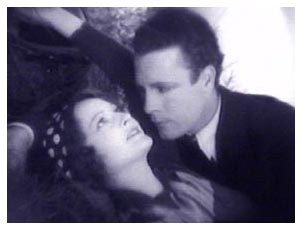 "We cut a hole in the side
of one of the boxes for the lens and shot real people along the
street. It looked as if there were four packing cases piled on
top of the cart, but we were able to fit the cameraman and his
camera in there. There are some other shots we were able to get
on location with a delivery truck. We used all sorts of signals
and chalk marks to get these candid shots. We worked out a system
of rehearsing without anyone knowing it. Between shots I'd lean
against the truck and talk to the cameraman inside. We were also
beginning to work without a lot of makeup, so the actors weren't
that noticeable."
"We cut a hole in the side
of one of the boxes for the lens and shot real people along the
street. It looked as if there were four packing cases piled on
top of the cart, but we were able to fit the cameraman and his
camera in there. There are some other shots we were able to get
on location with a delivery truck. We used all sorts of signals
and chalk marks to get these candid shots. We worked out a system
of rehearsing without anyone knowing it. Between shots I'd lean
against the truck and talk to the cameraman inside. We were also
beginning to work without a lot of makeup, so the actors weren't
that noticeable."
One of the most famous and outstanding shots from the late silent era is the tracking shot that begins at the bottom of a skyscraper, smoothly scales the building like a swift elevator, picks out a single window, sails through it, and isolates John's desk amidst hundreds of others. This stylized effect was achieved with scale models that were shot on their side and photographed with overhead wire trolleys that gave the illusion of the viewer being literally transported up the side of the skyscraper like a human fly. By the time we arrive at John's desk in a cavernous room filled with hundreds of identical desks, we recognize and welcome his familiar and likable face. As he watches the clock and waits for the workday to end, we can sense the sheer weight of the mass of humanity that he's up against.
There are no concessions to Hollywood sentimentality in this film. We may be drawn into the budding romance of John and Mary, but director Vidor concentrates on the harsh realities of emotional relationships and life itself. When John and Mary leave for their honeymoon at Niagara Falls, their friend (played by Bert Roach) who introduced them turns to his companion and says nonchalantly, "Well, I'll give them a year . . . maybe two." Years later, when their daughter lies dying, John vainly attempts to shut out the noise made by crowds and fire trucks outside their apartment, only to have a policeman shout at him, "Get inside! The world can't stop because your baby's sick!" Later, the funeral procession for the child is stripped of any sanctity. The small cortege consists of one hearse and two cars, which an insensitive traffic cop brusquely hurries along. Then John, sinking further into depression and crazed by grief, quits his job and tries to find another. He desperately attempts to join a line stretching from the employment office. "I've got to get a job," he pleads, "I've got a wife and kids." Elbowing John away, a man replies, "So have lots of us." Finally, John faces his lowest public moment when he is reduced to juggling balls while wearing a clown outfit and sandwich boards as he walks the streets of the city -- precisely the job he had laughed at in his younger, more cocky days.
Presenting this harsh and unsparing reality, Vidor does not pass judgment on the behavior of either the main characters or the surging backdrop of humanity; instead, he has us linger on the intimate scenes between John, Mary, and their struggling family. Some of these scenes are sweet and tender; others are filled with what Tennessee Williams has called "that cloudy, flickering, evanescent - fiercely charged! -- interplay of live human beings in the thundercloud of a common crisis." What they all have in common is the ring of truth; there isn't a hint, not even a whisper, of melodrama.
For example, the scenes of John and Mary's first Christmas
Eve together offer the audience a private moment behind closed
doors. Fleeing Mary's family, who think him a wastrel, John goes
to a friend's apartment in search of bootleg gin. He returns home
drunk late that night and finds Mary in bed, her face expressionless
until she looks at him with pity and love. "They don't understand
you," she says, "but that doesn't matter." With
the simplicity of a child, John asks, "Do YOU understand
me?" She nods and says (there is no title here, but we can
clearly lip-read), "I think I do." When John goes to
a 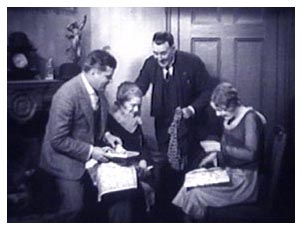 cupboard and retrieves his presents
for Mary, he looks at the little gifts, clutches them to his breast,
and fights back his tears. We understand at once his guilt, relief,
love and his desire to do better. It's almost a throwaway moment,
but one filled with poignancy. Most directors might have ended
the scene on this bittersweet note, but not Vidor. When John gives
Mary an umbrella and she raises it, he snatches it away from her:
"Wuzza idea - always doin' somethin' wrong?" And they
quarrel lightly as the scene fades. Vidor knew that scenes of
life do not end with neat resolutions.
cupboard and retrieves his presents
for Mary, he looks at the little gifts, clutches them to his breast,
and fights back his tears. We understand at once his guilt, relief,
love and his desire to do better. It's almost a throwaway moment,
but one filled with poignancy. Most directors might have ended
the scene on this bittersweet note, but not Vidor. When John gives
Mary an umbrella and she raises it, he snatches it away from her:
"Wuzza idea - always doin' somethin' wrong?" And they
quarrel lightly as the scene fades. Vidor knew that scenes of
life do not end with neat resolutions.
The ending is emphatically right for a film that has taken an unsparing yet compassionate look at humanity. Pressure from the M-G-M front office (Louis B. Mayer, not surprisingly, hated the picture) forced Vidor to shoot seven different endings, however. One, set in a mansion, featured John and Mary alongside a Christmas tree, rejoicing in John's new-found success. Mary says, "Honest, Johnny, way down deep in my heart, I never lost faith in you for a minute." Exhibitors were given a choice of endings, and Vidor later said that he never heard of the happy ending being shown anywhere. That happy ending appears not to have survived, and we daresay it's one that silent film buffs will never miss.
Though "The Crowd" made only a very modest profit (the average American was understandably reluctant to see his life played out before him with such brutal honesty), much of the critical reaction was excellent. While praising Vidor's masterful direction (he was nominated for an Academy Award), critics were especially struck (as we) by the performances of James Murray and Eleanor Boardman as John and Mary Sims. Boardman, Vidor's wife at the time, was already a star when she made this film. Interviewed by Brownlow for "Hollywood" fifty years later, the beautiful and elegant Boardman admitted that the part initially unsettled her:
"I didn't care about ordinary people. I thought that when you went into movies that you wore pearls and beautiful hats, and gorgeous clothes. Suddenly I was cast in this downtrodden Mary-Doe-meets-John-Doe type of story -- a boy and a girl going through life with no education, no money, no knowledge of what they were doing. It was a job that I had to do. I didn't like to be so drab and unattractive. My hair was hanging down, there was no makeup . . . I didn't object to it. I mean inwardly I did, but I made no objection about it. I had confidence in Vidor. He knew what he was doing."
What's surprising (and then exhilarating) about Boardman's early scenes is that she is so plain and dowdy, so natural, that she immediately registers as a real person -- not often the case with several silent-film actresses. Her Mary Sims is certainly no Patient Griselda; at one point she even slaps John and screams, "You luff! You quitter! I'd almost rather see you dead!" As the film progresses, however, her clear-eyed but unfaltering love for John has made her beautiful in his and our eyes. No matter that she may sometimes look frumpy or frazzled or lose her temper: when her love comes to the forefront again, she glows with a warmly human light. Watch as she tells John that she is pregnant: here is what the best of silent-film acting is all about.
James Murray is even more of a revelation. The 26-year-old Murray was an extra who had been a dishwasher, art student, florist, model, clerk and hobo. Speaking to Brownlow for the Hollywood series, Vidor remembered:
"I had a pretty clear idea of what the man should
look like, and I'd been looking around various places. One day
I was talking to someone and a 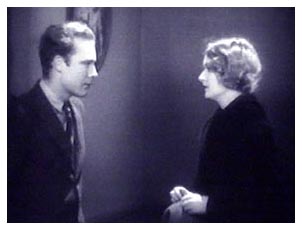 bunch
of extras was going by. This fellow stopped and jumped between
us -- did a little dance -- and I knew that he was
the fellow I'd been looking for. I followed him, got his name
and asked him to come to the studio. He didn't show up for about
two days, so I had to go back and look at all the names of the
extras working that day, remembering the one he'd told me, and
we called him and paid for a day's work to come out for an interview.
We made a test -- and he was miraculous."
bunch
of extras was going by. This fellow stopped and jumped between
us -- did a little dance -- and I knew that he was
the fellow I'd been looking for. I followed him, got his name
and asked him to come to the studio. He didn't show up for about
two days, so I had to go back and look at all the names of the
extras working that day, remembering the one he'd told me, and
we called him and paid for a day's work to come out for an interview.
We made a test -- and he was miraculous."
Murray's John Sims, charming and exasperating in equal measure, is arguably the most naturalistic performance that survives from the first thirty years of film. Watch his eyes when Mary tells him that she is pregnant; watch his face during the Christmas Eve scene; just watch him, period, when he realizes that his son loves him and when he appeals to Mary for a reconciliation. Only Spencer Tracy and James Stewart have since matched Murray in concealing their "acting" and simply existing onscreen as real human beings.
What gives Murray's performance extra poignancy is what eventually happened to him in real life. At the time of "The Crowd's" production, he was already hooked on alcohol. Vidor wanted him for Marion Davies' leading man in "Show People" (M-G-M, 1928) and for "Our Daily Bread" (M-G-M, 1934), his sequel to "The Crowd." The tormented Murray had sunk to hopeless alcoholism and was living on the skids. He defiantly refused what he presumed to be charity on Vidor's part. Ironically, Murray's corpse was pulled from the Hudson River a few years later, a tragedy eerily lifted from his contemplated suicide in his greatest film.
But Murray's art survives here with stabbing immediacy, as does that of Boardman and especially Vidor; standing as a pinnacle of silent film, "The Crowd" will continue to astonish and move us in years to come. For this story -- made up of dreams, disillusionment, tragedy, love, hope, and redemption -- is our own.
Works consulted:
Kevin Brownlow, "Behind the Mask of Innocence" and the
"Hollywood" series and accompanying book
James Card, "Seductive Cinema: The Art of the Silent Film"
William K. Everson, "American Silent Film"
George C. Pratt, "Spellbound in Darkness"